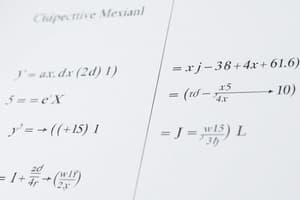Podcast
Questions and Answers
What is the fundamental connection between integrals and area under a curve?
What is the fundamental connection between integrals and area under a curve?
Integrals calculate the area under a curve represented by a function over a specific interval.
How does the derivative of a constant function inform us about its graphical representation?
How does the derivative of a constant function inform us about its graphical representation?
The derivative of a constant function is zero, indicating that the graph is a horizontal line with no slope.
Explain how the area of a circle formula is derived using calculus.
Explain how the area of a circle formula is derived using calculus.
The area of a circle can be derived by integrating the function for a semicircle, $y = rac{1}{2} imes ext{radius}^2$ over the interval of the circle's radius.
Discuss the significance of the Pythagorean Identity in trigonometry.
Discuss the significance of the Pythagorean Identity in trigonometry.
What does the integral of a constant function represent, and how is it expressed mathematically?
What does the integral of a constant function represent, and how is it expressed mathematically?
Why is finding the maximum or minimum of a function important in optimization problems?
Why is finding the maximum or minimum of a function important in optimization problems?
What is the purpose of the limit in calculus?
What is the purpose of the limit in calculus?
Explain the Power Rule in calculus and provide an example.
Explain the Power Rule in calculus and provide an example.
What are the main differences between indefinite and definite integrals?
What are the main differences between indefinite and definite integrals?
Describe the Chain Rule and give an example of its application.
Describe the Chain Rule and give an example of its application.
What does the Quotient Rule state and when is it used?
What does the Quotient Rule state and when is it used?
Flashcards are hidden until you start studying
Study Notes
Calculus
-
Definition: Branch of mathematics that studies continuous change, dealing with derivatives and integrals.
-
Key Concepts:
-
Limits: Fundamental concept for defining derivatives and integrals.
- Notation: (\lim_{x \to a} f(x))
-
Derivatives: Measure of how a function changes as its input changes.
- Notation: (f'(x)) or (\frac{dy}{dx})
- Rules:
- Power Rule: (\frac{d}{dx}(x^n) = nx^{n-1})
- Product Rule: (\frac{d}{dx}(uv) = u'v + uv')
- Quotient Rule: (\frac{d}{dx}\left(\frac{u}{v}\right) = \frac{u'v - uv'}{v^2})
- Chain Rule: (\frac{d}{dx}(f(g(x))) = f'(g(x))g'(x))
-
Integrals: Measure of the area under a curve.
- Indefinite Integral: Represents a family of functions.
- Notation: (\int f(x)dx)
- Fundamental Theorem of Calculus: Connects differentiation and integration.
- Definite Integral: Represents the area under the curve between two bounds.
- Notation: (\int_{a}^{b} f(x)dx)
- Indefinite Integral: Represents a family of functions.
-
-
Applications:
- Optimization problems (finding maximum and minimum values)
- Area and volume calculations
- Motion analysis (velocity and acceleration)
Formulas
-
Basic Algebra:
- Quadratic Formula: (x = \frac{-b \pm \sqrt{b^2 - 4ac}}{2a})
-
Geometry:
- Area of a Circle: (A = \pi r^2)
- Circumference of a Circle: (C = 2\pi r)
- Area of a Triangle: (A = \frac{1}{2}bh)
-
Trigonometry:
- Sine: (\sin(\theta) = \frac{opposite}{hypotenuse})
- Cosine: (\cos(\theta) = \frac{adjacent}{hypotenuse})
- Tangent: (\tan(\theta) = \frac{opposite}{adjacent})
- Pythagorean Identity: (\sin^2(\theta) + \cos^2(\theta) = 1)
-
Calculus:
- Derivative of a constant: ( \frac{d}{dx}(c) = 0)
- Integral of a constant: (\int c , dx = cx + C)
-
Statistics:
- Mean: (\bar{x} = \frac{\sum x_i}{n})
- Variance: (\sigma^2 = \frac{\sum (x_i - \bar{x})^2}{n})
- Standard Deviation: (\sigma = \sqrt{\sigma^2})
-
Exponential and Logarithmic Functions:
- Exponential Growth: (y = ae^{bt})
- Natural Logarithm: (\ln(x)) is the inverse of (e^x)
-
Miscellaneous:
- Distance Formula: (d = \sqrt{(x_2 - x_1)^2 + (y_2 - y_1)^2})
- Slope of a Line: (m = \frac{y_2 - y_1}{x_2 - x_1})
Calculus
-
Branch of mathematics focusing on continuous change, involving derivatives and integrals.
-
Limits:
- Essential concept in calculus for defining derivatives and integrals.
- Notation: (\lim_{x \to a} f(x)).
-
Derivatives:
- Represents the rate of change of a function as its input changes.
- Common notations include (f'(x)) or (\frac{dy}{dx}).
- Key Rules:
- Power Rule: (\frac{d}{dx}(x^n) = nx^{n-1}).
- Product Rule: (\frac{d}{dx}(uv) = u'v + uv').
- Quotient Rule: (\frac{d}{dx}\left(\frac{u}{v}\right) = \frac{u'v - uv'}{v^2}).
- Chain Rule: (\frac{d}{dx}(f(g(x))) = f'(g(x))g'(x)).
-
Integrals:
- Calculate the area under a curve.
- Indefinite Integral: Represents a family of functions, noted as (\int f(x)dx).
- Fundamental Theorem of Calculus: Links differentiation with integration.
- Definite Integral: Measures area under a curve between two limits, expressed as (\int_{a}^{b} f(x)dx).
-
Applications:
- Solving optimization problems to find maximum and minimum values.
- Calculating areas and volumes of geometric shapes.
- Analyzing motion through velocity and acceleration.
Formulas
-
Basic Algebra:
- Quadratic Formula used to solve (ax^2 + bx + c = 0): (x = \frac{-b \pm \sqrt{b^2 - 4ac}}{2a}).
-
Geometry:
- Area of a Circle: (A = \pi r^2).
- Circumference of a Circle: (C = 2\pi r).
- Area of a Triangle: (A = \frac{1}{2}bh).
-
Trigonometry:
- Sine: (\sin(\theta) = \frac{opposite}{hypotenuse}).
- Cosine: (\cos(\theta) = \frac{adjacent}{hypotenuse}).
- Tangent: (\tan(\theta) = \frac{opposite}{adjacent}).
- Pythagorean Identity: (\sin^2(\theta) + \cos^2(\theta) = 1).
-
Calculus:
- Derivative of a constant: (\frac{d}{dx}(c) = 0).
- Integral of a constant: (\int c , dx = cx + C).
-
Statistics:
- Mean: (\bar{x} = \frac{\sum x_i}{n}).
- Variance: (\sigma^2 = \frac{\sum (x_i - \bar{x})^2}{n}).
- Standard Deviation: (\sigma = \sqrt{\sigma^2}).
-
Exponential and Logarithmic Functions:
- Exponential Growth Model: (y = ae^{bt}).
- Natural Logarithm: (\ln(x)) serves as the inverse function of (e^x).
-
Miscellaneous:
- Distance Formula: (d = \sqrt{(x_2 - x_1)^2 + (y_2 - y_1)^2}).
- Slope of a Line: (m = \frac{y_2 - y_1}{x_2 - x_1}).
Studying That Suits You
Use AI to generate personalized quizzes and flashcards to suit your learning preferences.




